Connectors of Sequence and Conclusion. Discover the most common connectors of sequence and conclusion and how to use them effectively.
Tag: grammar

Cause and Effect Connectors Words
Cause and Effect Connectors Words. Learn how to use cause and effect connectors words to write clear and concise sentences.
What is Voice in Grammar?
Discover how voice can affect the clarity and effectiveness of your writing. Improve your grammar skills with this in-depth guide to voice.
What is a verb mood?
Learn about the three verb moods in English and how to use them correctly.

Non-finite Verbs: Meaning, Types, and Examples
Non-finite verbs are a key part of the English language. This blog post will explain what non-finite verbs are, how they work, and provide examples.

Finite Verbs: Meaning, Types, and Examples
Finite verbs are a key part of the English language. This blog post will explain what finite verbs are, how they work, and provide examples.

Intransitive Verbs: Meaning, Types, and Examples
Intransitive verbs are a key part of the English language. This blog post will explain what intransitive verbs are, how they work, and provide examples.

Transitive Verbs: Meaning, Types, and Examples
Transitive verbs are a key part of the English language. This blog post will explain what transitive verbs are, how they work, and provide examples.

Irregular Verbs: Meaning, Types, and Examples
Irregular verbs are a challenge for many English learners. This blog post will explain the different types of irregular verbs and provide examples so you can learn how to use them correctly.

Regular Verbs: Meaning, Types, and Examples
Learn about regular verbs, their meaning, types, and examples. This blog post will help you understand how regular verbs work and how to use them in your writing.

Helping Verbs: Meaning, Types, and Examples
Helping Verbs: Meaning, Types, and Examples Verbs play a vital role in sentence construction, expressing actions, states, or occurrences. Among them, helping verbs, also known as auxiliary verbs, assist main verbs in conveying more precise meanings and verb tenses. Understanding helping verbs and their various types is essential for constructing grammatically correct and meaningful sentences. […]

What is a Reciprocal Pronoun? Definition, Usage, and Examples
Do you know what reciprocal pronouns are? Learn the definition, usage, and examples of reciprocal pronouns in this blog post.

What is a Possessive Pronoun? Definition, Usage, and Examples
Possessive pronouns can be tricky, but this blog post will make them easy to understand. Learn the definition, usage, and examples of possessive pronouns in this clear and concise guide.

Complex Sentences with Subordinating Conjunctions
Learn how to use subordinating conjunctions to create complex sentences. Complex sentences are made up of an independent clause and one or more dependent clauses. The independent clause can stand on its own as a complete sentence, but the dependent clause cannot. Subordinating conjunctions help to connect the independent and dependent clauses, and they can be used to show a variety of relationships between the clauses.
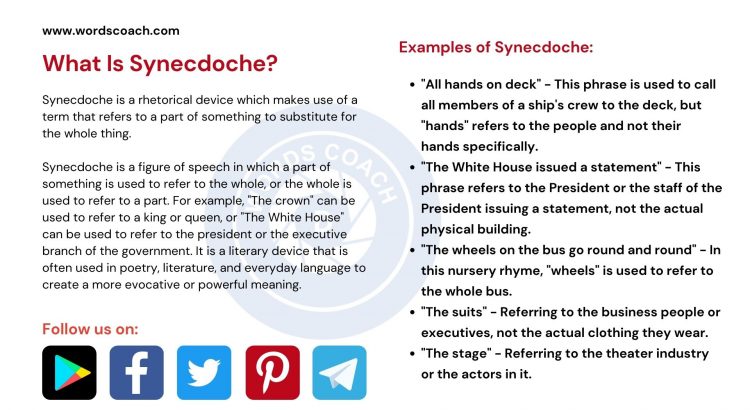
What Is Synecdoche? – Meaning and Definition
Synecdoche is a rhetorical device which makes use of a term that refers to a part of something to substitute for the whole thing.
What Is Synecdoche? – Meaning and Definition
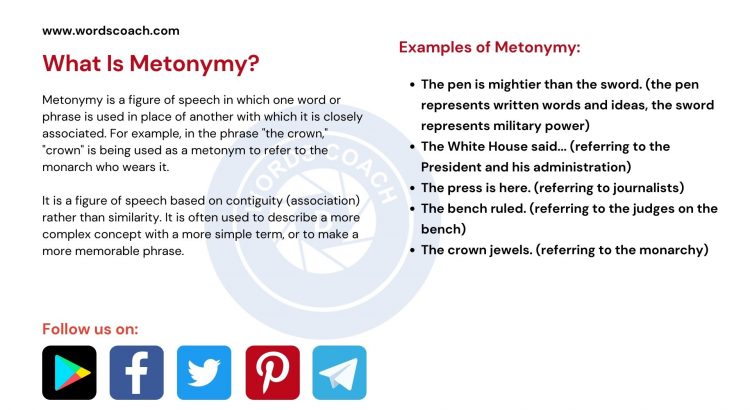
Metonymy – Definition, Meaning, and How to Use with Examples
Metonymy is a figure of speech in which one word or phrase is used in place of another with which it is closely associated. For example, in the phrase “the crown,” “crown” is being used as a metonym to refer to the monarch who wears it.
Metonymy – Definition, Meaning, and How to Use with Examples

Pun – Definition, How to Use, and Examples
A pun is a form of wordplay that exploits multiple meanings of a term, or of similar-sounding words, for an intended humorous or rhetorical effect. These plays on words often rely on verbal humor and can be used to create puns in written or spoken language. These plays on words can take the form of homophonic, homographic, metonymic, or other types of puns.
Pun – Definition, How to Use, and Examples
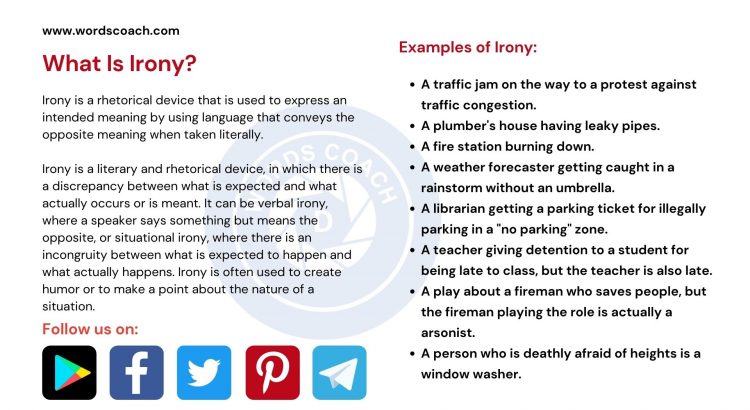
What Is Irony? – Meaning and Definition
Irony is a rhetorical device that is used to express an intended meaning by using language that conveys the opposite meaning when taken literally.
What Is Irony? – Meaning and Definition
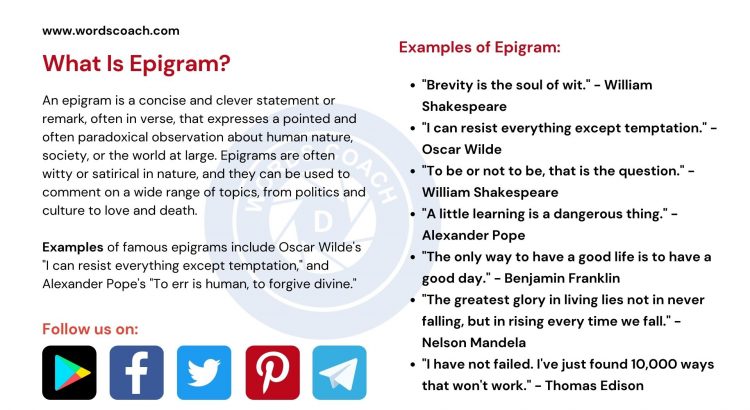
Epigram – Explore Meaning, Definition, and Examples
An epigram is a concise and clever statement or remark, often in verse, that expresses a pointed and often paradoxical observation about human nature, society, or the world at large. Epigrams are often witty or satirical in nature, and they can be used to comment on a wide range of topics, from politics and culture to love and death.
Epigram – Explore Meaning, Definition, and Examples
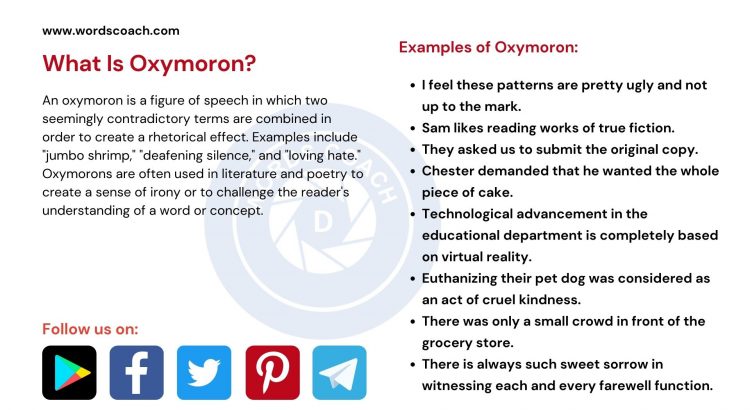
What Is Oxymoron? – Meaning and Definition
An oxymoron is a figure of speech in which two seemingly contradictory terms are combined in order to create a rhetorical effect. Examples include “jumbo shrimp,” “deafening silence,” and “loving hate.”
What Is Oxymoron? – Meaning and Definition

Antithesis: Meaning, Definition and Examples
Antithesis is a figure of speech in which contrasting ideas or words are placed in close proximity to one another to create a balanced effect. It is often used to highlight the contrast between two ideas or to create a sense of tension. Examples of antithesis include phrases such as “love and hate,” “black and white,” and “rich and poor.” In literature, antithesis is often used to create a sense of tension or conflict, and to demonstrate the complexity of characters or themes.
Antithesis: Meaning, Definition and Examples
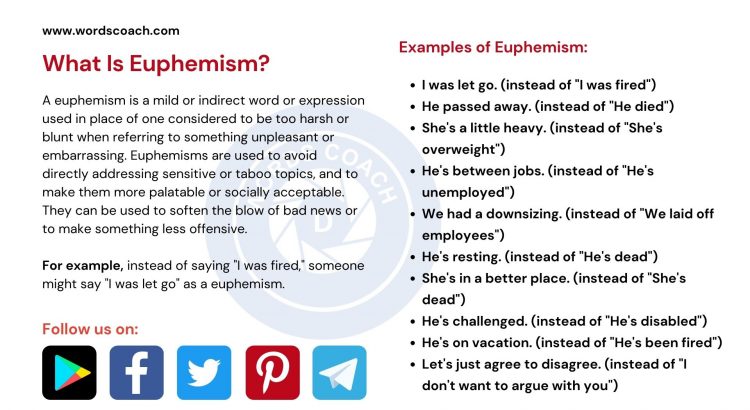
What Is Euphemism? – Meaning and Definition
A euphemism is a mild or indirect word or expression used in place of one considered to be too harsh or blunt when referring to something unpleasant or embarrassing. Euphemisms are used to avoid directly addressing sensitive or taboo topics, and to make them more palatable or socially acceptable. They can be used to soften the blow of bad news or to make something less offensive.
What Is Euphemism? – Meaning and Definition
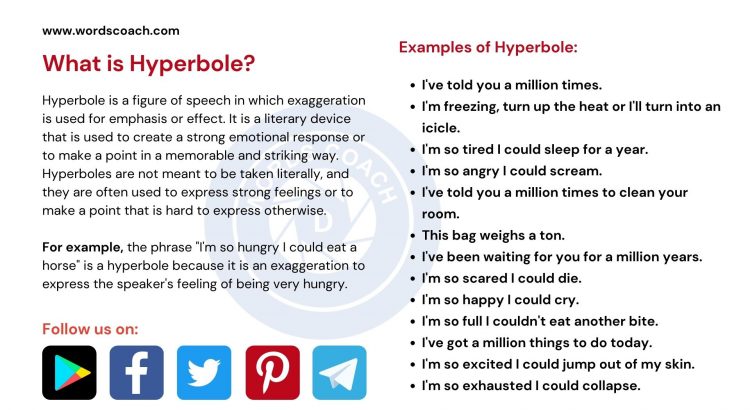
What Is Hyperbole? – Meaning and Definition
Hyperbole is a figure of speech in which exaggeration is used for emphasis or effect. It is a literary device that is used to create a strong emotional response or to make a point in a memorable and striking way. Hyperboles are not meant to be taken literally, and they are often used to express strong feelings or to make a point that is hard to express otherwise.
What Is Hyperbole? – Meaning and Definition
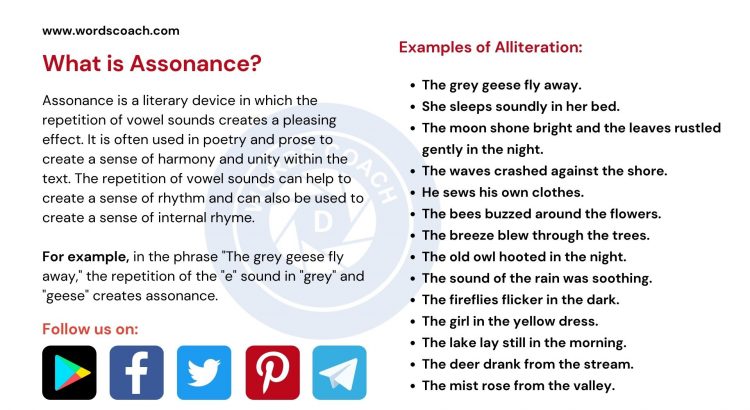
Assonance – Meaning, Definition, Usage and Examples
Assonance is a literary device in which the repetition of vowel sounds creates a pleasing effect. It is often used in poetry and prose to create a sense of harmony and unity within the text. The repetition of vowel sounds can help to create a sense of rhythm and can also be used to create a sense of internal rhyme.
Assonance – Meaning, Definition, Usage and Examples
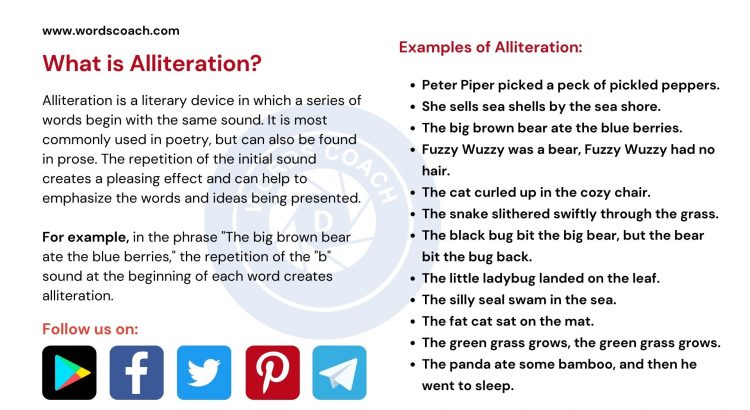
Alliteration: Definition, Usage & Examples
Alliteration is a literary device in which a series of words begin with the same sound. It is most commonly used in poetry, but can also be found in prose. The repetition of the initial sound creates a pleasing effect and can help to emphasize the words and ideas being presented.
Here are 20 examples of alliteration:

